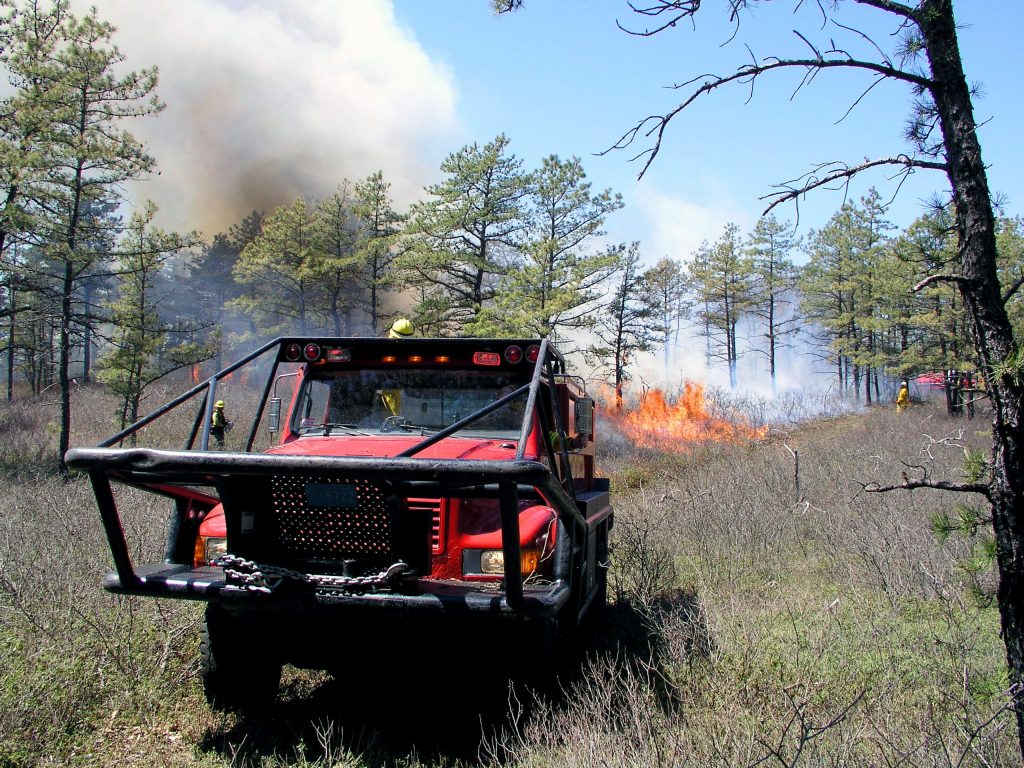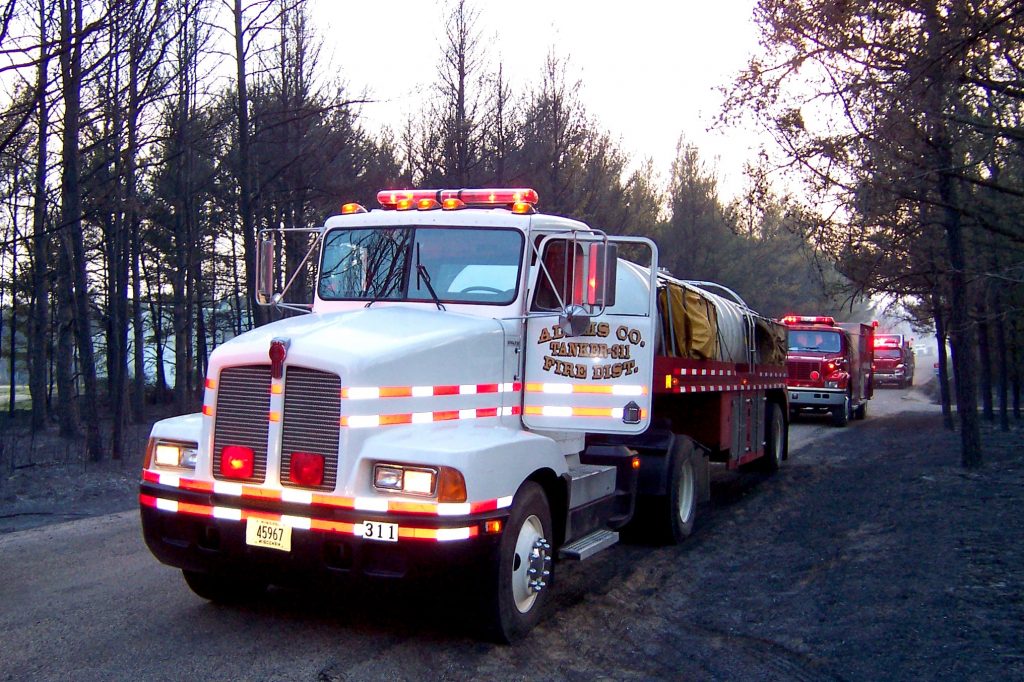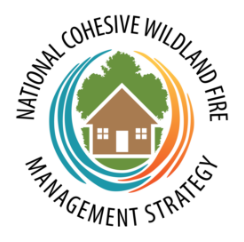National Cohesive Strategy, Goal Three
Wildfire response
All jurisdictions participate in making and implementing safe, effective, efficient risk-based wildfire management decisions.
This section provides a set of links and resources to assist wildland fire managers and practitioners with information to support a safe, effective, and efficient response to wildfires in the Northeast Region.

COVID-19 Wildland Fire Response Plans & Guides
The NE RSC has compiled a set of current resources and guides developed by Northeast wildland fire management partner agencies and organization in response to the COVID-19 pandemic situation. Go to the COVID-19 web page here.
The Role of the Fire Service in Community Planning
The fire service has a proud history of fire prevention efforts to educate citizens on the threat of fires originating inside the home, mostly in the urban setting. EDITH (Exit Drills in the Home), Stop Drop and Roll, Sparky and Put a Finger on It are instantly recognizable themes for fire prevention programs. Similarly, forestry agencies have a history dating to the 1920s of educating citizens on the need to prevent forest and wildland fires. It is rare to find someone who can’t immediately recall the tag line “only YOU can prevent forest fires” when shown a picture of Smokey Bear.
With the growth of wildland-urban interface (WUI) fires, the local fire department is uniquely positioned as a trusted voice in the community to advocate for and lead community planning efforts. In addition to emergency response, many fire departments have the authority and responsibility to cooperate with all stakeholders to mitigate the risk of WUI fires. Looked to as role models, fire departments can initiate and lead mitigation efforts that benefit not only the firefighters themselves, but the community, its infrastructure and resources.
Role of fire departments in CWPPs
Recognized for their leading role in many community events and programs besides emergency response, local fire departments can serve as an organizing force in developing a Community Wildfire Protection Plan (CWPP). Fire departments can serve as the lead in developing a CWPP or they can support a community effort. Fire departments will have special expertise when developing a community risk assessment, establishing hazard reduction priorities and educating the public on recommendations to reduce structural ignitability.
Benefits of Community Wildfire Planning to Firefighter and Public Safety
Leading or participating in a community effort to reduce wildfire and WUI fire risk can benefit wildfire response by firefighters in many ways. Conducting hazard reduction activities based on a community risk assessment not only reduces risk to the citizens, but it also improves firefighter safety. A community risk assessment can inform the development of a WUI tactical map or pre-fire plans that maximize the efficiency and safety of wildfire response.
Programs and Tools
- The Wildland Fire Learning Portal (Learning Portal) is an enterprise learning management system that enables the national wildland fire community to better meet their education and training needs.
- NE Cohesive Strategy Overview for Fire Depts A brief set of slides that provides an overview of the Cohesive Wildland Fire Management Strategy in the Northeast-Midwest U.S.
- Ready, Set, Go!® program The RSG! Program tenets help residents be Ready with preparedness understanding, be Set with situational awareness when fire threatens, and to Go, acting early when a fire starts.
- Wildfire Home Assessment Program & Checklist The Wildland Fire Assessment Program (WFAP) is a joint effort by the U.S. Forest Service and the National Volunteer Fire Council (NVFC) to provide volunteer firefighters and non-operational personnel, such as Fire Corps members, with training on how to properly conduct assessments for homes located in the wildland-urban interface (WUI).
WUI Chief’s Guide – This guide was developed by the IAFC’s Wildland Fire Policy Committee to help provide a better understanding of the wildland-urban interface and the necessary information to help prepare, mitigate, respond, and recover from these events. The guide helps individuals understand how a fire chief or other official can help a community effectively manage the emerging risk of fires in the wildland-urban interface. Each section contains information and advice, case studies, and where possible, links to applicable resources.
Fire Adapted Communities for the Fire Service – This free, online training course is designed for members of fire and emergency response organizations operating in an area with wildland urban interface (WUI). It will introduce them to the key components of working with their community to adapt to the wildland fire threat. The course takes up to two hours to complete and includes interactive features such as knowledge checks and learning activities. This course was developed by the IAFC, as part of its cooperative agreement with the U.S. Forest Service. Log into or create your free IAFC Academy/Helix account to register HERE. If you are a registered member of the RSG! Program you already have a Helix account.
- CWPP Leader’s Guide This is a guide from the International Association of Fire Chiefs (IAFC) is designed to help develop and implement a Community Wildfire Preparedness Plan in communities and across the country. It has a local community level approach to include code, development review, ordinances and local authority, and is used by leaders in the Fire Service, including SMEs and local, state, and federal officials. With the guidance of this guide, leaders in the Fire Service will be able take the steps to create a CWPP that addresses community risk of wildfire with respect to other resource values.
- FEMA/U.S. Fire Administration – Wildland Urban Interface (WUI) toolkit Resources to help your fire department prepare for, and respond to, WUI fires.
- NOAA/NWS Storm Prediction Center Wildfire Probability Interactive Map An interactive map system showing the probability of a wildfire of various sizes by date of the year. You can choose what size fire you’re interested in, 100, 300, 1,000, or 5,000 acres and allow the map to animate the entire year, or manually step through in three-day intervals. The data is based on wildfire occurrence between 1992 and 2015.

EACC and Compacts
- The Eastern Area Coordination Center (EACC) serves Federal and State wildland fire agencies within the twenty-state Eastern Area (EA). EACC provides logistical and resource support, predictive services, and intelligence for anticipated and ongoing wildland fire activity. EACC facilitates movement of resources (people, aircraft, ground equipment) among the EA member agencies and their individual units.
- Forest Fire Compacts facilitate the sharing and coordination of information, prevention efforts, training, fire management knowledge, lessons learned, and resources. The four Forest Fire Compacts covering the 20 Northeast-Midwest States are:
- Northeast Forest Fire Compact: Maine, New Hampshire, Vermont, Massachusetts, Connecticut, Rhode Island, New York, Quebec, New Brunswick, Nova Scotia, and Newfoundland.
- Mid-Atlantic Forest Fire Compact: Ohio, Pennsylvania, New Jersey, Delaware, Maryland, Virginia, and West Virginia.
- Great Lakes Forest Fire Compact: Michigan, Wisconsin, Minnesota, Ontario, and Manitoba.
- Big Rivers Forest Fire Management Compact: Illinois, Indiana, Iowa and Missouri.
Wildfire Reporting Resources and Guides
Wildland fire reporting is a critical function in the planning, budgeting, and strategic execution of wildland fire management programs at the federal, state, and local levels. Some key fire reporting resources can be found at:
- Integrated Reporting of Wildland-Fire Information (IRWIN) The Integrated Reporting of Wildland-Fire Information (IRWIN) service is an investment intended to enable “end-to-end” fire reporting capability. IRWIN provides data exchange capabilities between existing applications used to manage data related to wildland fire incidents. IRWIN focuses on the goals of reducing redundant data entry, identifying authoritative data sources, and improving the consistency, accuracy, and availability of operational data.
- National Fire Plan Operations and Reporting System (NFPORS) The National Fire Plan Operations and Reporting System (NFPORS) is an inter-departmental, inter-agency automated data management and reporting system developed, operated, and maintained by the Department of the Interior (DOI) collaboratively with the Department of Agriculture (USDA). In the science analysis of The National Strategy, NFPORS was used to identify fuel treatments and activities by Federal agencies and Bureaus.
- National Fire Incident Reporting System The National Fire Incident Reporting System (NFIRS) is a reporting standard that fire departments use to uniformly report on the full range of their activities, from fire to Emergency Medical Services (EMS) to severe weather and natural disasters.
- InFORM The Interagency Fire Occurrence Reporting Modules InFORM is comprised of three applications: two for field use – called Survey123 and Collector – and one web-based application – called Inspector – that is best utilized on a desktop or laptop computer.
- Survey123 is a great tool for non-federal and tribal agencies, because it allows users to submit incidents to IRWIN without WildCAD. When run from a GPS-enabled cell phone or tablet at the fire scene, Survey123 can automatically capture the fire’s location as a point. Point data can be entered to initiate the record only or expanded to meet the data needs of a final fire report.
Collector is the best tool for submitting polygon data on smaller fires. Collector can be used on a GPS-enabled cell phone or tablet to capture a perimeter for any incident reported through IRWIN.
Inspector is a web-based application that users can view, edit, and input fire report data directly into the IRWIN environment. Under normal circumstances, most of the data in a fire report will have been entered through upstream applications, such as WildCAD and FAMWeb209. Inspector is used to review and edit that data, complete all required data fields, and certify the report as “final.” Inspector replaces fire occurrence reporting systems for federal agencies. For assistance with uploading state fire occurrence data, see the State Bulk Upload Fires via *.CSV video

